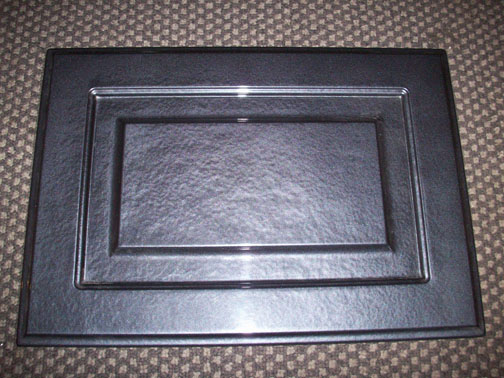Waxy Stripper Residue Problem
How to get stripper residue off imperfectly stripped and sanded doors, before spraying an opaque finish. May 7, 2009
Question
I have some doors that I tried to strip a few months ago and would like to spray white. Doors were previously sprayed with Chemcraft stain, then topcoated with two coats of MLC Krystal. Anyways, the finish blushed and I tried to strip using a furniture stripper and all it did was mess up the Krystal, but wouldnít remove it real well. So I stacked them and ordered new doors.
Now I am trying to spray some of these old doors white with Clawlock and Krystal. I took the doors and sanded smooth, not to bare wood, just so it was smooth, using 150 grit paper. This removed most of the Krystal mush left behind by the stripper. I then tried spraying the tinted Clawlock and little spots appeared that wouldnít dry. Iím guessing little bits of stripper is still on the doors and reactivated. Anyways, after that long saga, is there something I can wipe on the doors to neutralize the furniture stripper before I spray a new finish on them. I should mention itís a dichloromethane stripper.
Forum Responses
(Finishing Forum)
From contributor B:
Dichloromethane strippers contain wax which stops the stripper from evaporating too quickly. This wax will interfere with any coating you put on top. Wash down with cellulose thinner or any degreasing solvent. Wipe clean while the solvent is still wet. If you just let the solvent dry of its own accord, the wax will remain on the surface. I wash down twice, wipe clean, let the job dry, and then it should be ok. You can apply a coat of shellac as a barrier.
From the original questioner:
Sanding for the most part made them okay, but the corners and grooves proved troublesome as I couldnít really get the paper in there well. Glad I only started with a few samples instead of spraying the whole lot. Would you recommend something like TSP or mineral spirits?
From contributor B:
I don't know what TSP is, but I think mineral spirits isn't strong enough. In England we have cellulose thinners, or panel wipe, or any of the solvents used by car painters for degreasing. Any of these should do the job.
From the original questioner:
TSP is tri-sodium phosphate. It is typically used as a cleaner/degreaser prior to painting. Apparently itís good stuff. I have used it on concrete floors prior to painting but never on wood. I guess I will give it a shot on one door and see what happens. I like your idea of the sealer coat with shellac. This should do the trick.
From contributor D:
Try wiping the "waxy" areas with a damp water rag and let dry. This trick seems to pull out the wax, and allows future coats to dry properly.
From contributor A:
Dewaxed shellac makes a great seal coat to lock in waxes and other contaminants. Then coat as usual. It saves all kinds of problems.
From contributor O:
I use "Swing" brand strippers (made in Montreal) and have found that stripping with the thicker, "gel" type and washing off with the thinner "liquid" type before the gel dries, is very effective. After the piece is dry, I sand and wash with thinners, then refinish.
For doors, especially with tougher finishes (like CV's), I have found scuffing with 80grit, applying gel stripper and then stacking the doors, sometimes with an old towel between each, and leaving them overnight works really well. The finish usually just peels off. A stiff bristle brush and the liquid stripper cleans out any crud remaining in detailed work or on the edges.
From the original questioner:
It was the swing gel stripper I used and it was on CV. Iím just trying to refinish and spray a solid color on them and blow them out for cheap. I hate to just throw them out and Iím tired of looking at them.
From Paul Snyder, forum technical advisor:
If you lightly swipe the tacky spots with a cloth wetted with naphtha it will allow them to dry much faster. Otherwise, they will dry and harden eventually, but it takes more than a full day. You have to swipe very lightly because it's easy to damage the finish where it's still tacky. Last time I had the same problem. I had completely stripped the doors, washed them down extremely well and still had the tacky finish in the corners where the panel meets the rails and stiles. I set the doors aside and forgot about them for a couple weeks. When I re-checked them, they were fine.
